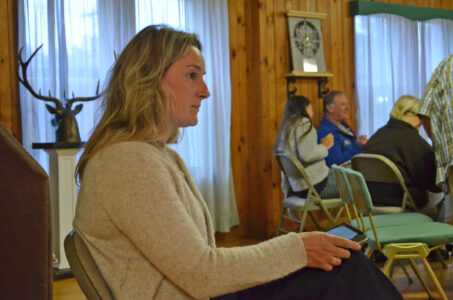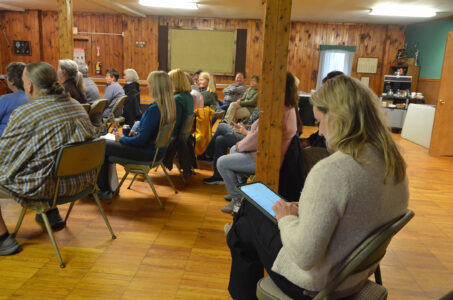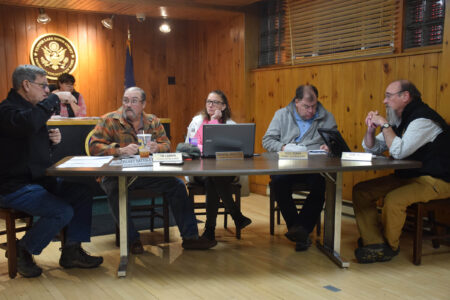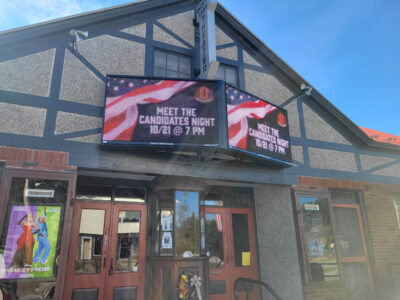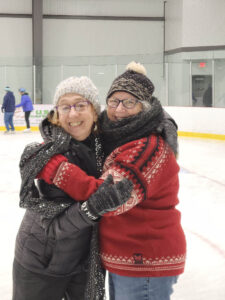Heads, hugs and Hoosiers
Local nonprofits part of Indiana University research on democracy and civic life
- Miona Amoriell fills out a survey from researchers at Indiana University, in the back of the Saranac Lake Winter Carnival monthly meeting on Tuesday. She’s been sitting in on recent meetings and events of local “civil society organizations,” collecting data for a social science study. (Enterprise photo — Aaron Marbone)
- Miona Amoriell fills out a survey from researchers at Indiana University, in the back of the Saranac Lake Winter Carnival monthly meeting on Tuesday. She’s been sitting in on recent meetings and events of local “civil society organizations,” collecting data for a social science study. (Enterprise photo — Aaron Marbone)
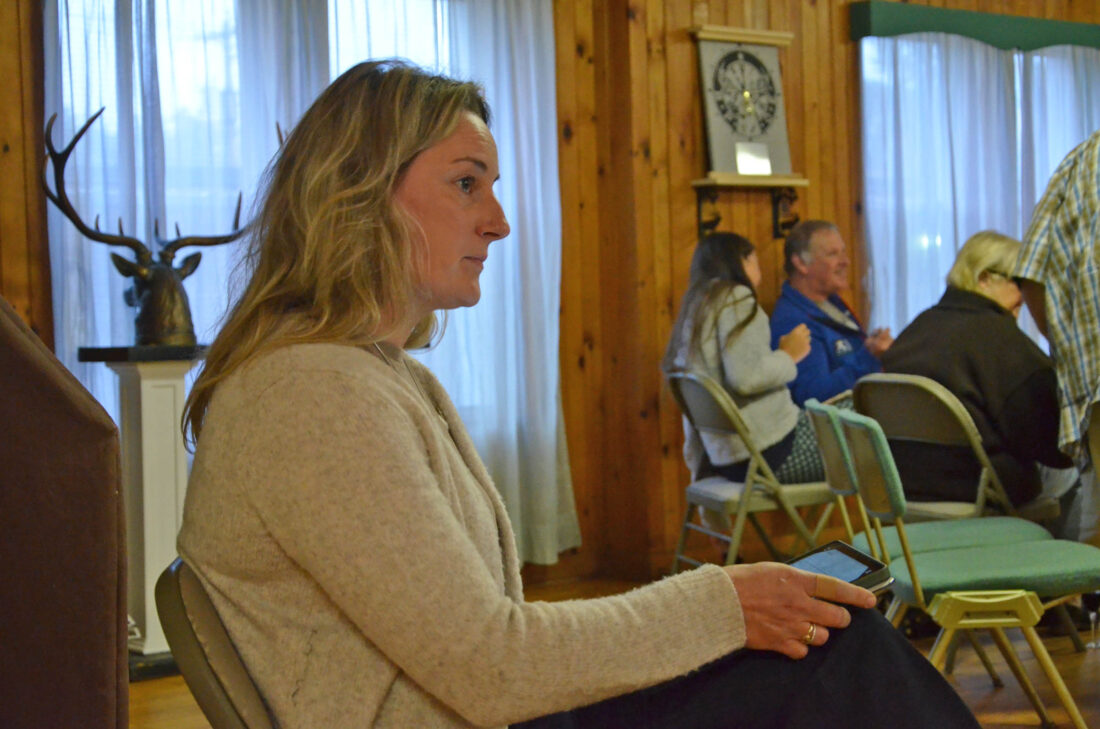
Miona Amoriell fills out a survey from researchers at Indiana University, in the back of the Saranac Lake Winter Carnival monthly meeting on Tuesday. She’s been sitting in on recent meetings and events of local “civil society organizations,” collecting data for a social science study. (Enterprise photo — Aaron Marbone)
SARANAC LAKE — Miona Amoriell sat in the back of the Saranac Lake Winter Carnival monthly meeting on Tuesday, counting heads, taking note of how decisions were made and tallying every time people hugged.
She was collecting data for a social science study by Indiana University.
Amoriell, of Lake Placid, has been sitting in on recent meetings and events of local “civil society organizations,” collecting data on the groups to be used in a variety of research papers.
The Tri-Lakes has been selected as one of four regions in America where researchers are collecting data on volunteer organizations, clubs, advocacy groups, religious entities, arts organizations, chambers of commerce and hobby groups to learn more about how civic life impacts people and how people impact civic life.
When volunteers in the Adirondacks meet, where do they meet? How do they make decisions? How many of them are there? What’s the temperature of the room? How often do they shout at each other? What are their goals?
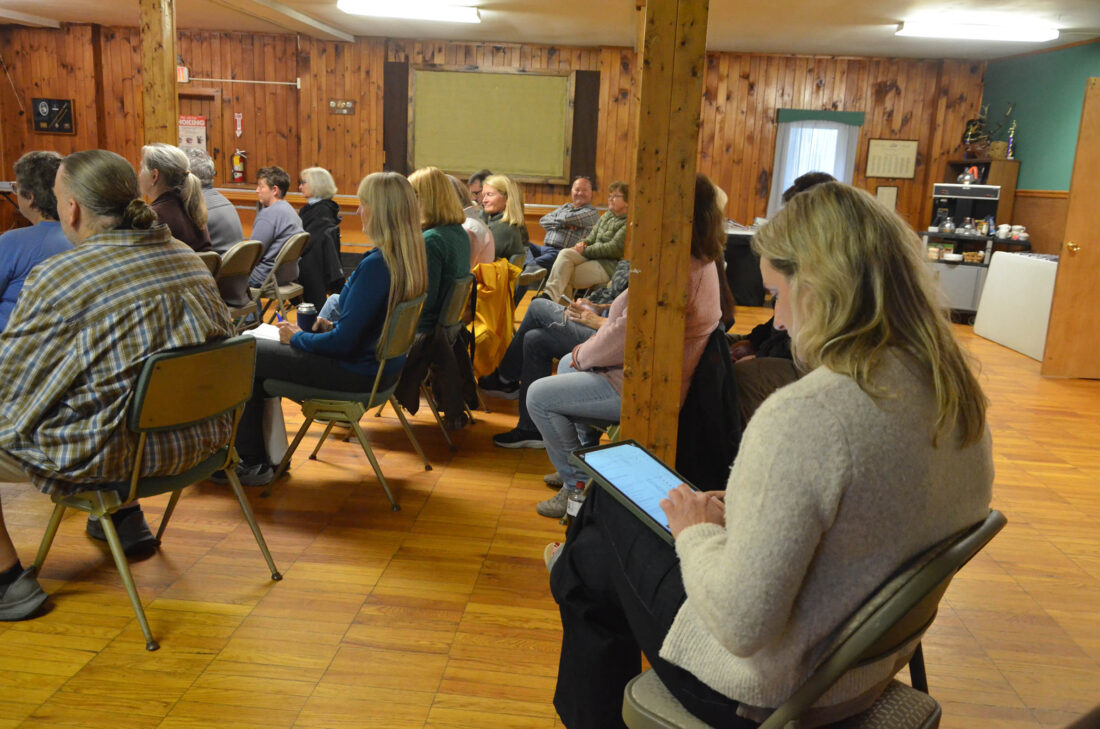
Miona Amoriell fills out a survey from researchers at Indiana University, in the back of the Saranac Lake Winter Carnival monthly meeting on Tuesday. She’s been sitting in on recent meetings and events of local “civil society organizations,” collecting data for a social science study. (Enterprise photo — Aaron Marbone)
These are just a few of the questions the study is seeking to answer.
–
Democracy
–
The idea for this study started 15 years ago while Matthew Baggetta — now the co-director of the Observing Civic Engagement Lab at Indiana University — was working on his doctorate, doing a study of community choirs in the Boston area. He had designed a survey for members to fill out.
But as he attended rehearsals and handed out surveys, he realized there were interesting quirks about the gatherings that he could see, but were invisible to the participants.
“It’s the water you swim in, it’s the air you breathe, so you don’t think about it,” Baggetta said.
For this study, they created an elaborate survey form with more than 1,000 variables on it and trained people in target areas on how to fill them out and what to look for while viewing meetings. The survey includes things as detailed as room temperature, as broad as if religion or politics are discussed and as basic as if food or alcohol is served at the event.
The survey started in Bloomington, Indiana, where Indiana University is. Its organizers wanted to expand it to include nonprofits in rural communities. They expanded to Idaho, Iowa and the Adirondacks.
In total, the study has 50 people in the four locations collecting data. Amoriell is one of three in the Tri-Lakes, along with Sarah Sheridan and Isabella Susino. She started in mid-June and will continue through May. She’s observing 27 organizations with a goal to try to hit 30. Her cousin saw the job listing and knew Amoriell would be a great fit. Amoriell was sent to a five-day training in Indiana to learn how to fill out the survey.
This data collection effort could easily inform a dozen studies, Baggetta said. The researchers have many questions they’re trying to answer, so they’re having the surveyors collect a lot of data while they’re allowed this behind-the-scenes view of how nonprofit and volunteer organizations work.
Baggetta said there are four papers in the works using the Bloomington data, with more on the way. He expects that the data from the Tri-Lakes will be used in six or so papers in the near future. Eventually, the researchers would like to write a book about their findings.
“People who study democracy have talked for literally hundreds of years about these kinds of organizations and the roles they can play in making democracy work,” Baggetta said.
In 1835, the French diplomat and writer Alexis de Tocqueville visited the U.S. and wrote his greatly important book, “Democracy in America.” Baggetta said de Tocqueville argued that the United States was the most democratic nation in the world — in part, because of how many civil society groups it has.
He said they’ll make the data available to other scholars to use, and share their methods and tools, to let others collect more data.
This isn’t just science for science’s sake, Baggetta said — they want their findings to benefit communities. In January, they’ll share some preliminary results with the organizations they surveyed so they can use it to get an outside look at themselves.
Baggetta had hoped to get the Tri-Lakes in the study. He grew up in Johnstown and spent summers at a camp his grandfather built on Fourth Lake.
Trust for Civic Life, a partnership of national grantmakers and a funder of the university study, identified that the Tri-Lakes community has had demographic changes in recent years in terms of economics and nationality. It is interested in “communities in transition.” Amoriell is observing some religious and community groups making sure people from other countries are welcome and have resources to start lives in the U.S.
In the Adirondacks, the age range of involvement in civic life groups appears to trend older.
“We live in a society where we — intentionally or otherwise — really separate people by age group.” Baggetta said. “Young people do younger people things. Older people do older people things. And we really don’t mix them together that much. That’s sort of unusual in human history. For most of human history, we had a lot more age integration.”
He wants to see what settings encourage age integration and which do not.
When he was studying Boston choirs, he saw a lot of gray hair and the people there told him they wanted younger people to join their groups.
Amoriell has seen that here. She believes volunteerism trends older because younger people are busy building careers or families. But she also said, when she saw the need for herself, she wanted to find the time.
“I think everybody can cut out a couple hours here and there,” she said.
One of the focuses of the study is the physical space people meet in. The researchers are studying the way a room affects the people in it.
They’re interested in how decisions are made. Since these groups are often led by volunteers, there might be a reluctance to take charge. They’re curious if having a volunteer-led group makes it harder or easier to make decisions.
There’s disagreement in the academic world about how much social interaction happens at these events. Some believe there’s a lot of meaningful connections. Others believe people sit in a room, listen to someone talk and walk away.
Baggetta said they have a hypothesis — that these groups are places where people mix and interact a lot. So they set out to test it.
–
Showing up
–
Do people show up on time? Do people stay afterward and talk? (Baggetta calls this “the meeting after the meeting.”) How are decisions made? Is there discussion and consensus, or one person telling the group what will happen? Are meetings formal or informal? Do they talk about the news or politics — local or national?
By asking questions like these, they can answer bigger ones, like “What makes people more connected?” or “How do groups attract younger volunteers?”
Just through counting hugs, shouting and interrupting Baggetta said they’ve seen interesting dynamics.
This happened in three organizations observed in Bloomington. One had no hugs, no shouting and no interrupting. Another had lots of interrupting but no hugging. The third had lots of interrupting and shouting but also a lot of hugging.
“Just with those three measures we start getting a sense of the kinds of dynamics at these organizations that are quite different,” Baggetta said. “You would never get that if you didn’t count how many times people shout or hug.”
They don’t have hard data for local organizations yet, but in talking with surveyors, he said they’re noticing local civic cultures and traditions. In some areas, people tend to arrive at meetings and events on time. In other places, the start and end of an event have a softer boundary.
Baggetta felt the Adirondacks has a distinctive civic community because it has lots of tourist infrastructure and smaller year-round communities.
Amoriell sees many of the same people volunteering in different groups.
Gathering 30 groups to observe seemed like such a daunting task when she started. But as she started reaching out to people, she had a “domino effect” of referrals.
In her training, she had been told that only 10% of organizations would likely agree to be observed. But, that percentage was much higher here. Only a few said “no,” some just didn’t respond, but most were excited to be viewed.
Amoriella has seen people sharing meals, shooting films, caring for people with disabilities, singing, organizing events and advocating for causes to the government.
The work is tedious sometimes, but she enjoys it a lot.
She’s lived in the Tri-Lakes for nine years but said she really didn’t know how tight the community is until she started observing organizations.
She majored in English in Serbia and works part-time as a substitute teacher. She’s considering getting a master’s degree and now thinks she might do it in social science.
“I get paid to go and watch people,” she said with a laugh. That’s really what social studies is all about.
Amoriell said it’s hard to just be a “fly on the wall.” Volunteers are always needed and nearly every group tries to recruit her.
Amoriell actually plans on volunteering with an organization to help elders after the survey is finished. After observing their work, she said it struck a chord with her.
“I can now see firsthand how important and how fulfilling that is,” Amoriell said.
She described her reason for volunteering as “selfish reasons.” By that, she means she enjoys helping people.
The study is currently funded through May. If it gets more funding, it could continue after that.

